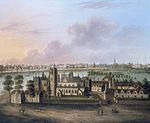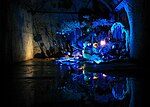Waterloo East railway station

Waterloo East railway station, also known as London Waterloo East, is a railway station in central London on the line from Charing Cross through London Bridge towards Kent, in the south-east of England. It is to the east of London Waterloo railway station and close to Southwark tube station. The station opened in 1869 as Waterloo Junction, to provide a connection between the London and South Western Railway at Waterloo, and the South Eastern Railway at Charing Cross. A dedicated line was built between Waterloo and Waterloo East, which was later converted to a footpath. Trains originally ran to Cannon Street, but after competition from the London Underground, these were withdrawn as a wartime measure in 1916. The station continued to be connected to Waterloo mainline via a footbridge. Waterloo East was given its current name in 1977, and remains an important interchange in London. It is part of the London station group.
Excerpt from the Wikipedia article Waterloo East railway station (License: CC BY-SA 3.0, Authors, Images).Waterloo East railway station
Sandell Street, London Lambeth (London Borough of Lambeth)
Geographical coordinates (GPS) Address Nearby Places Show on map
Geographical coordinates (GPS)
| Latitude | Longitude |
|---|---|
| N 51.5037 ° | E -0.111 ° |
Address
Waterloo East Railway Station
Sandell Street
SE1 8SW London, Lambeth (London Borough of Lambeth)
England, United Kingdom
Open on Google Maps










